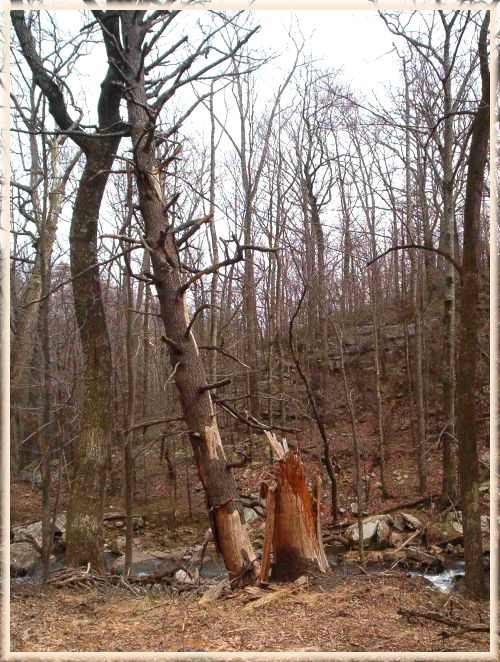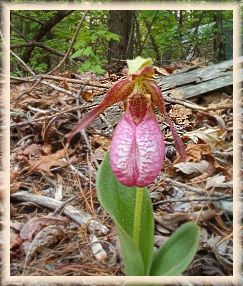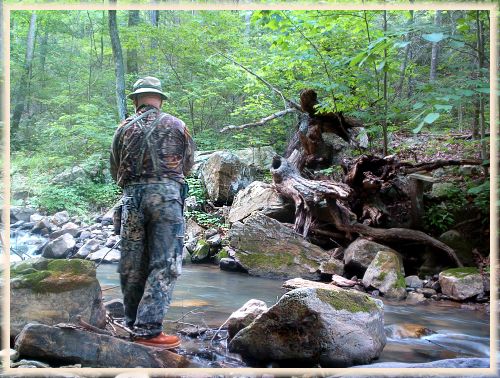
Even from the roadside far above, the sound of captured
water forced through the narrow passageways of moss-draped
rocks barely hints at the nutrient rich steep gradient
stream that lies below.
The small pool at the base of the "arrowhead" shaped rock
is the normal starting point to an upstream passage from
this locale. It harbors a few good specimens if one
approaches quietly and lays out a size ten elk hair caddis
with a 6X or finer tippet. The largest taken from this pool
turned out to be a surprising fourteen inch brown with hues
of color that put a rainbow to shame.

The growth rate of the browns and rainbows in this
watershed is phenomenal and was documented this
past fall during an electro-shock sampling conducted
by the Department of Game and Inland Fisheries. I was
able to tag along as an observer and an invited
participant of the survey. The fingerlings introduced
during the previous six month period had one fin clipped
for identification purposes and to differentiate them
from the naturally reproducing population and
older previous stockings.
Continuing upstream one is confronted with a dying
population of once stately hemlocks; now broken and
riddled with a boring insect sounding the death knell
for them, much as the chestnuts beforehand. The woolly
adelgid, an Asian native, was discovered in the U.S.
in 1924. It has no known predators here.

The mile length of this stream lies at the bottom of a
gorge and even in the warmer months it funnels cool misted
air through a canopy of covering leaves. One encounters
plunge pool after pool with very few long flat runs. No
tightly looped forty foot casts here; rather, a rod's
length flip of the fly; sometimes underhanded serves you
well. A custom built seven and a half foot two piece rod
is usually the weapon of choice in this neighborhood. The
overhead cast has resulted in the catching of multiple
"tree trout" and the "release" of many flies unto them!
The opportunity to photograph many specimens of flowers
and plants abounds in the park along streamside. One early
February day, a speck of bright yellow ahead seemed totally
out of place. Closer inspection revealed an already brightly
blooming dandelion streamside.

Besides the favored elk hair caddis the next best producer
is a small black foam ant topped with a brilliant orange
foam "sight minder" for the aging eyeball. Have also tried
nymphs with limited success and any type of indicator used
gets as many or more hits then your fly. The strikes on
this stream are probably the most aggressive encountered
and a three inch fingerling would give "Jaws" a run for
the money.
As you trek farther upstream there is one area that holds
an unpleasant surprise for the unwary or possibly uneducated
mountaineer. A particularly steep and hemlock laden run begs
one to exit the stream and detour around it. The natural
course between two waist high boulders must not be taken
whilst wearing shorts nor swinging any portion of one's
unprotected skin through the tall green foliage that
grows there. On my only short wearing traverse, midway
through the "rock passageway," the stings of a gazillion
barbed hot pokers assailed my bare legs. Instead of quickly
forging on ahead I made the mistake of reaching down to part
the foliage with my left hand. Now, it too was ablaze.
Ah - the childhood remembrance of the "stinging nettle"
was quickly retrieved from my subconscious storage. No
amount of cool water dunking served to relieve the itch
and pain the rest of the day. It actually would flare up
and continued to torture me for about a week afterwards.

Most trips to this favored stream are shared with only
the occasional deer, squirrel or bird. There is very
little traffic except for the occasional fly fisher or
streamside hiker. The lower level of the stream in the
park area has a steady stream of visitors along the
well-maintained trails and the fishing there is the
put and take variety occasioned by stockings of twice
or more a year. Park Rangers conduct series of nature
walks and plant identification throughout the summer
time and the picnicking facilities in the park area
are excellent.

A trip to this stream is magical any time of year. The
scenery constantly changes and after heavy spring rains
the stream bed is in constant motion. Last weeks pool
is this weeks flat run; the wood dam run at the bottom
of the big falls is once again fishable for a short pace
and the "three rock" tail out has deep undercuts once more.
If you can't recharge your batteries on a visit to this
place then they are surely dead.

If I may so bold as to quote Betty's FAOL signature:
"Trout don't live in ugly places." ~ Dick Taylor (Grn Mt Man)
|







